|
On the last Wednesday of every month, I serve up a potpourri of advice, inspiration and other tidbits I've come across in recent weeks. Because October has been such a beautiful time to be outdoors and enjoy nature, this month's installment features words about the natural world. Adopt the pace of nature: Her secret is patience. -- Ralph Waldo Emerson So, then: What's wilderness? Maybe wilderness is a place of isolation, of solitude. Maybe wilderness is a place where, through your solitude, you reach toward some larger power or mystery. You could be at the top of Mount McKinley, or you could be in a vacant lot in Colorado Springs, with weeds growing up around the broken bottles. What more do we get out of wilderness when we think of it as our own solitude? -- Poet David Mason, interviewed in The Sun, April 2015 In all things of nature, there is something of the marvelous. -- Aristotle I don't think I can learn from a wild animal how to live in particular . . . but I might learn something of mindfulness, something of the purity of living in the physical senses and the dignity of living without bias or motive. -- Annie Dillard We still do not know one-thousandth of one percent of what nature has revealed to us. -- Albert Einstein The act of looking, of paying attention, is akin to prayer for me. It can be transporting. I particularly love observing plants. I like climbing mountains and paddling rivers and chasing butterflies, too, but plants are my doorway to wonder. -- Robin Wall Kimmerer, interviewed in The Sun, April 2016 I willingly confess to so great a partiality for trees as tempts me to respect a man in exact proportion to his respect for them. -- James Russell Lowell The earth has its music for those who will listen. -- George Santayana This grand show is eternal. It is always sunrise somewhere; the dew is never all dried at once; a shower is forever falling; vapor is ever rising. Eternal sunrise, eternal sunset, eternal dawn and gloaming, on sea and continents and islands, each in its turn, as the round earth rolls. -- John Muir, John of the Mountains: The Unpublished Journals of John Muir Nature is not a place to visit. It is home. -- Gary Snyder No bonus this month, because instead of adding more content here, I'm going outside for another dose of nature! I encourage you to do the same. See you again soon.
12 Comments
If I invited you to come with me to the "most attended public art event on the planet," where do you suppose we'd go? Paris, perhaps? New York? Some quaint California town? 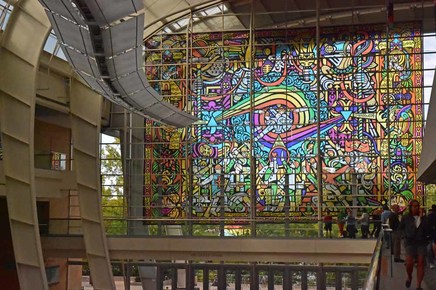 ArtPrize visitors take in one of the installations in DeVos Place ArtPrize visitors take in one of the installations in DeVos Place What if I told you that the event takes place here in West Michigan? It's called ArtPrize, and it draws some 400,000 visitors to Grand Rapids over a nineteen-day period in early autumn. Unless you've experienced ArtPrize first-hand, grasping its scope, scale and concept can be mind-warping. When I try explaining it to out-of-towners who've never attended, they grope for comparisons. "So it's a big art fair, like Ann Arbor's," they venture. No, it's not like that. 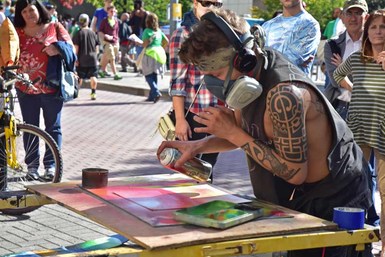 An artist draws a crowd at ArtPrize An artist draws a crowd at ArtPrize "So it's some kind of festival of the arts, with performances, exhibits and activities?" No, Grand Rapids has one of those in the spring, but that's not ArtPrize. 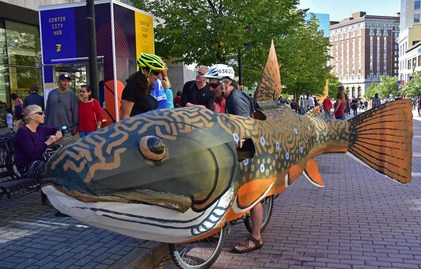 ArtPrize fosters a festive feeling ArtPrize fosters a festive feeling Maybe this will help. In a recent conversation, some of my hiking friends were comparing notes on their visits to this year's ArtPrize. Peg, still euphoric over her day-long excursion, said, "There are no carnival rides, there's nothing to buy, yet it feels like a festival."  Where else can you see so many people gathered just to view and discuss art? Where else can you see so many people gathered just to view and discuss art? Anita added in an almost reverent tone: "And all these people come, just to look at art!" Still not getting it? Let's try some facts and figures. ArtPrize is an international art exhibit and competition that takes place in 170 locations—from museums and galleries to bars, bridges, laundromats and auto body shops—over a three square mile downtown area. The event is free to the public, who can vote for their favorites using mobile devices and the ArtPrize web page. Cash prizes, half of which are decided by public vote and half by a jury of art experts, total $500,000. Any artist can enter, and any space in the district can be a venue. "It’s unorthodox, highly disruptive, and undeniably intriguing to the art world and the public alike," the ArtPrize web site asserts. 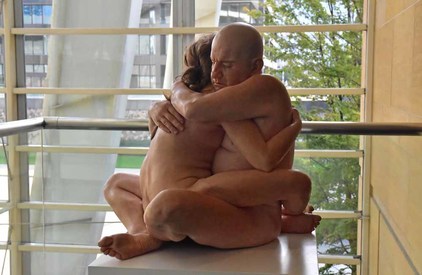 "Embrace," by Marc Sijan, prompted double takes and spirited comments "Embrace," by Marc Sijan, prompted double takes and spirited comments What intrigues me most are the stated objectives of celebrating artists who take risks and promoting "examination of opinions, values and beliefs, encouraging all participants to step outside of their comfort zones." As Ray and I toured this year's ArtPrize--the eighth annual--with our friend Emily, we encountered works that made us stop and stare and others that made us stop and think. Some brought us close to tears; some were just plain fun. 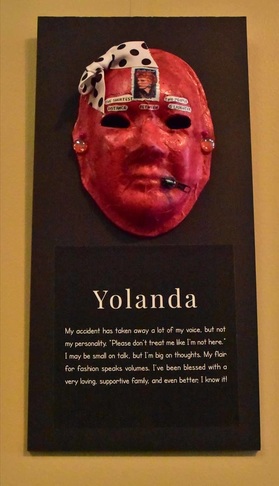 One moving display featured life-sized masks made by people with brain injuries, along with each artist's personal story. 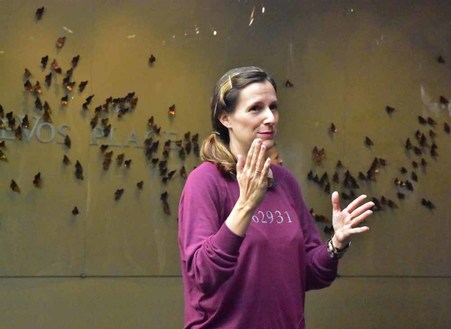 Allison Leigh Smith discusses "The Butterfly Effect" Allison Leigh Smith discusses "The Butterfly Effect" Just down that hall from that collection was "The Butterfly Effect," an installation of 1,234 handmade bronze Monarch butterflies. Artists Bryce Pettit and Allison Leigh Smith created the work to call attention to the plight of Monarchs, whose numbers have dropped dramatically over the past 20 years. 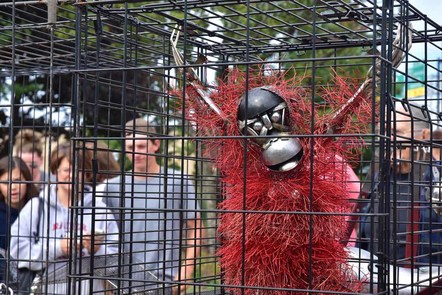 After wandering outside and crossing a bridge to the other side of the Grand River (encountering a hula-hooping guitar player on the way), we came upon an assortment of sculptures that looked whimsical at first glance. But the creatures artist Justin La Doux crafted from recycled materials peered at us from cages, making a statement about the cruelties of the illegal pet trade. 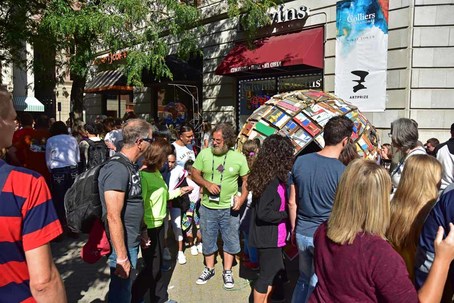 Naji (in green t-shirt) talks to visitors about his construction, "Emoh," seen behind him Naji (in green t-shirt) talks to visitors about his construction, "Emoh," seen behind him In another area, we found a crowd gathered around Loren Naji's "Emoh" sculpture/time capsule and temporary home. Constructed from debris salvaged from abandoned Michigan and Ohio homes, Emoh (Home, spelled backwards) represents wastefulness and the irony of homelessness in cities riddled with vacant houses. During ArtPrize, Naji lived in the eight-foot-diameter orb. Afterward, he planned to embark on a multi-city tour, collecting letters and discarded items from visitors at each stop. At the end of the tour, Emoh will become a time capsule, with those collected objects and writings stored inside for ten years until the capsule is opened on Earth Day 2026. 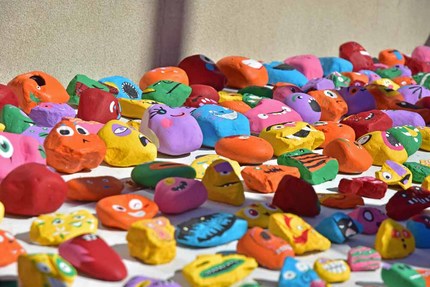 Another ambitious—but more light-hearted—undertaking was showcased down the street from Emoh. Grand Haven illustrator Aaron Zenz and his six children collected 1000 rocks in different shapes and sizes and painted faces (or facial features) on each one. The rocks were painted in matching pairs, with one member of each pair displayed outside the Grand Rapids Children's Museum, where we saw them, and the other 500 hidden around town for people to find, photograph and post on social media. (Read more about the Zenz family's project, "Rock Around" in this MLive article.) We didn't look for rocks, but we did go on our own treasure hunt, searching for work by Newaygo-area artists we know. 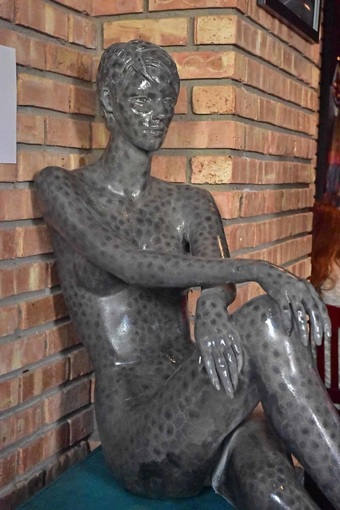 Eric LeMire's "Hexagonaria Percarinata" was easy to spot in the vestibule of a downtown pub. Eric used multiple layers of acrylic and poly resin to simulate the patterns of Michigan's state rock, the Petoskey stone, on a seated figure, a piece he hopes will stimulate interest in Michigan's "unique and rather exotic geological history and our human relationship with it" 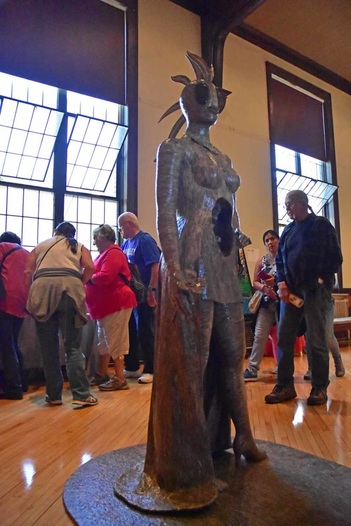 And we found Kim Froese's "Bee the Queen" holding court in First Congregational Church. Kim uses bald-faced hornets' nests in her art, and this piece celebrates the role of females (insect and human) in home and family. 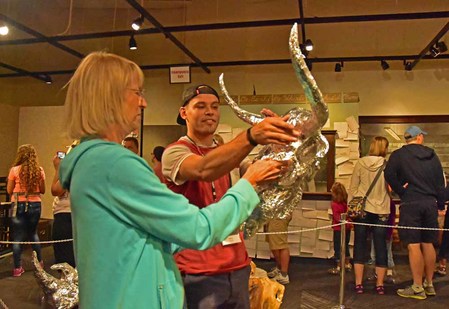 Tracy Cole's foil steer skull caught Emily's eye. Cole's other foil creations included a giraffe and a rhino, as well as smaller critters like the lizard below Tracy Cole's foil steer skull caught Emily's eye. Cole's other foil creations included a giraffe and a rhino, as well as smaller critters like the lizard below Kim's not the only artist who makes use of unconventional materials. This year we saw works of art created with aluminum foil, sand, duct tape and other surprising media. 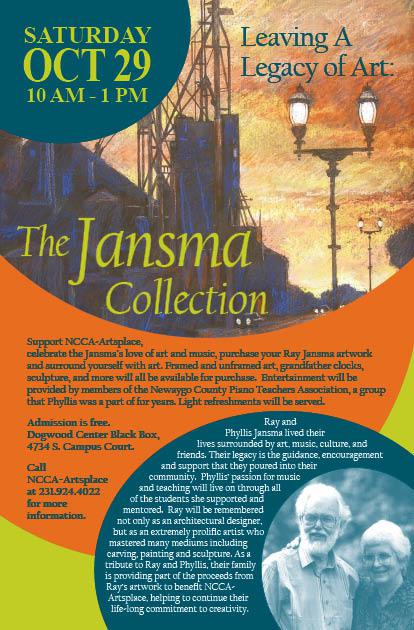 ArtPrize is over now, but we still have plenty of reminders of the place of art in our lives One upcoming event, in particular, highlights the impact artists can have on the community. "Leaving a Legacy of Art: The Jansma Collection," celebrates the lives of longtime Fremont residents Ray and Phyllis Jansma, who had a profound influence on Newaygo County's cultural scene. Phyllis was a musician and music teacher, Ray an architectural designer and artist who painted, sculpted and carved wood. As a tribute to Ray and Phyllis, their family is offering some of Ray's artwork for sale, with a portion of the proceeds to benefit Newaygo County Council for the Arts-Artsplace. The sale takes place Saturday, October 29 from 10 am to 1 p.m. at the Dogwood Center Black Box, 4734 S. Campus Court, Fremont. Admission is free, and light refreshments will be served. Entertainment will be provided by members of the Newaygo County Piano Teachers Association, of which Phyllis was a member for years. I'm looking forward to the event, and I'll tell you all about it in a future post. But for now, tell me something. Where do you go to see art that inspires, elevates and even challenges you to step outside your comfort zone?
Holidays: they're fun, they're festive, and sometimes they're just so much bother. The shopping, the cooking, the decorating, the entertaining, the cleaning up. Have you ever wished someone would designate a holiday just for loafing and doing whatever you please? 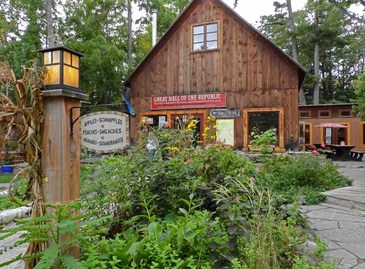 Cherry Republic Cherry Republic Some folks in the northern Michigan village of Glen Arbor had that wish—and made it happen. Two years ago, Cherry Republic, a purveyor of sweet and savory cherry delicacies, created the mid-October holiday of Leaf Day. The idea, as the company announced in its 2014 mail order catalog, was "to celebrate the amazing colors of fall, and to take a day to reflect or enjoy the outdoors in the last of our good weather." 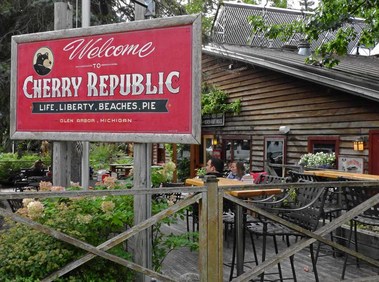 On the designated day, Cherry Republic gave employees the day off and encouraged other employers to follow suit, offering a gift box of the company's goodies to the first 25 bosses who granted the holiday to their staffers. Really, would you expect any less of a business whose motto is "Life – Liberty – Beaches – Pie"? 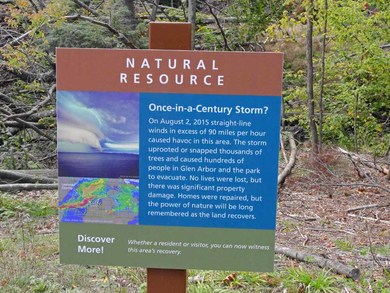 Sign alongside the Sleeping Bear Heritage Trail Sign alongside the Sleeping Bear Heritage Trail The idea was so popular within Cherry Republic, the company continued the tradition last year. Last October's Leaf Day was even more meaningful, as only a couple of months before, a sudden shear storm had destroyed tens of thousands of the area's magnificent trees.
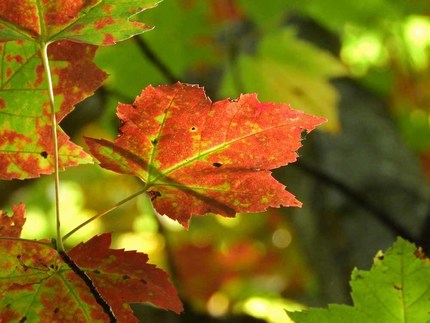 Not one mentioned rushing through a mall, slaving over a stove or eating to excess. 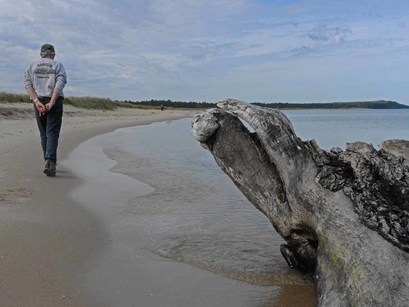 A walk along the lakeshore A walk along the lakeshore This year's Leaf Day is scheduled for October 17, but Ray and I got a sneak preview last week during a camping trip to Sleeping Bear Dunes National Lakeshore, right in Cherry Republic's backyard. It was a little early for the glorious display of color we've seen there in other years, and in fact this fall has been so wet, we thought it might be more appropriate to celebrate Mushroom Day. 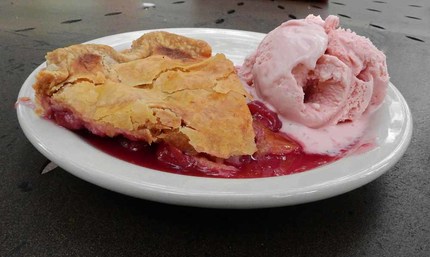 Cherry Republic's True Cherry Pie and Smooth Cherry ice creammmmmmm! Cherry Republic's True Cherry Pie and Smooth Cherry ice creammmmmmm! But by the end of our five days of hiking, biking, loafing and yes, eating pie at Cherry Republic, tinges of scarlet, russet and gold had begun to color leaf tips, and we felt we'd adequately kicked off the season. Kicked off, but not capped off. With Leaf Day still ahead, we're looking forward to celebrating nature in our own back yard. And from the looks of the maples around our house, it'll be a grand celebration. Will you celebrate Leaf Day this year? Or will you come up with your own holiday? What will you celebrate, and how will you choose to celebrate it?
On our recent road trip, we had the good fortune wander into Joel Rayburn's establishment, GlassBoy Studios and Tourist Trap Tees, in Arcadia, Oklahoma. 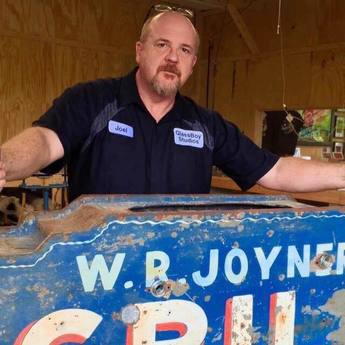 Joel Rayburn (Photo courtesy of Joel Rayburn) Joel Rayburn (Photo courtesy of Joel Rayburn) I was so captivated by Joel's stories and enthusiasm, I wanted to share more about his projects with you. 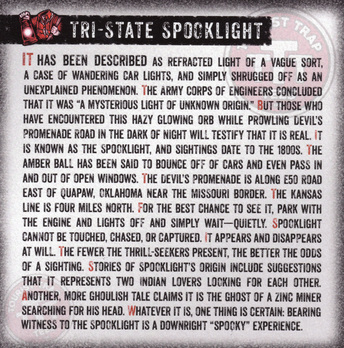 Back of one of the handout cards Back of one of the handout cards Joel fell in love with the stories and signs of Route 66 after moving from Tennessee to Oklahoma in 2007. To share his passion, he created a collection of T-shirts and hand-out cards memorializing some of the Mother Road's most enduring legends and legendary tourist traps. After serving an apprenticeship with neon artist David Rivers, Rayburn now practices the craft in his own studio, recreating vintage signs from the highway's heyday. Come along with me for a visit with Joel. 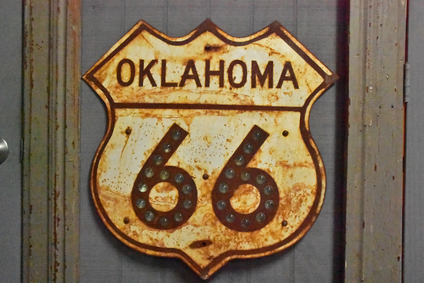 How did your interest in Route 66 begin, and what keeps it going? I really kinda stumbled upon Route 66. I had heard about Route 66 all my life, but was never just drawn to it. After moving to Oklahoma City from Philadelphia, I spent the weekends just investigating the surrounding area and taking weekend road trips. Route 66 happened to be five blocks from my home, and I thought I would see how far I could get on it going west. 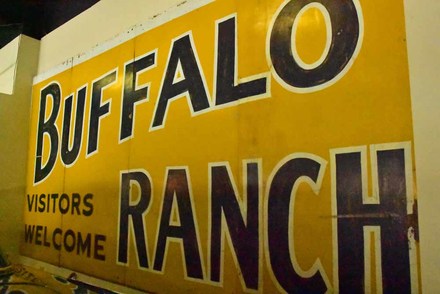 Old tourist attraction sign, now on display in Afton Station Packard Museum, Afton, Oklahoma Old tourist attraction sign, now on display in Afton Station Packard Museum, Afton, Oklahoma Needless to say, I was hooked from that first day on the Route. I believe it reminds me of the road trips that I used to take with my parents as a kid. My parents were always seeing new things and taking really long road trips in the 60s and 70s. The Route just transported me in time to a place that held a lot of comfort for me. The last road trip that I was to take with my parents was on Route 66. Pretty fitting, seeing that my future is now with the Route. 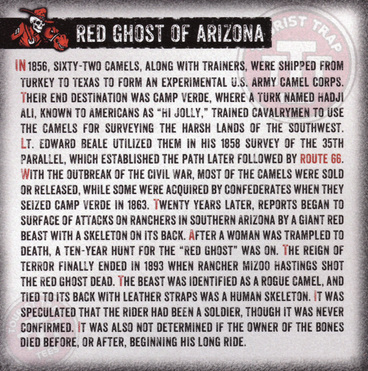 Another spooky Route 66 story Another spooky Route 66 story When did you begin collecting stories about Route 66, and why? Where do you see this project going? I seem to have been privileged to be surrounded by some of the Route’s great artists, historians and road archaeologists. They all seem to have their little areas that fascinate them, and my area seems to center around the weird and unusual. I love collecting stories that lie deep under the pavement of the Route. It’s fun to hang out with Jim Ross, Shellee Graham and Jerry and Kathy Anderson and introduce them to a weird story about the Route that they have never heard of. It’s like “Stump The Route Royalty!” Right now we just use the stories as inspiration for our Tourist Trap Tees business. We have knocked around compiling all the stories one day into print, but we are just having fun sharing these new unearthed stories with our guests. 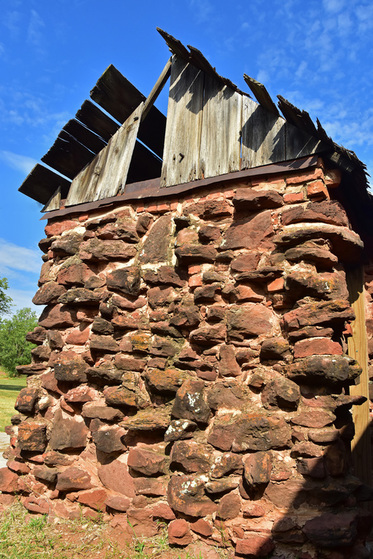 Remains of abandoned Route 66-era building in Warwick, Oklahoma Remains of abandoned Route 66-era building in Warwick, Oklahoma How do you hope these stories will appeal to younger generations? Why is this important? I am a child at heart and grew up watching "In Search Of . . . " with Leonard Nimoy. There is something in a kid that is fascinated about the unknown or the unusual. Most people think that my maturity level is equal to that of the younger generations. The stories seem to ignite that sense of wonder and adventure within me, and I believe that thread runs through all generations. GlassBoy Studios is really geared toward the young and younger generations. If you visit the studio, you will understand. I want to catch the imaginations of the young so that we can have the assurance that the Route will survive through their interest. 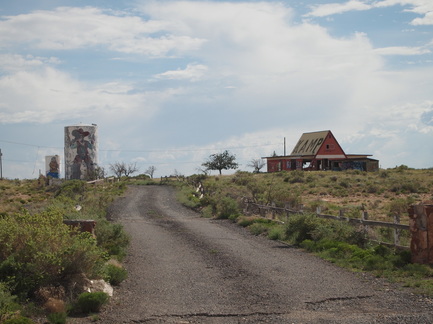 2013 photo of Two Guns, Arizona (Photo: Wikipedia) 2013 photo of Two Guns, Arizona (Photo: Wikipedia) Do you have a favorite Route 66 story? I think the Apache Death Cave story out of Two Guns, Arizona. "Two Guns, Arizona began and ended as a tourist stop where Route 66 crosses Canyon Diablo west of Winslow. It is also the site of an Indian battle that was later fully exploited by the site’s operators and ultimately became part of the highway’s lore. "As the story goes, in 1878, Navajo settlements in north central Arizona became prey to Apache raiders from the south, who would attack and then inexplicably disappear. After one such raid, their hideout in Canyon Diablo, a cave, was discovered by a Navajo scout. After surrounding the cave, the Navajos built a raging fire at the narrow entrance, which was kept blazing throughout the night. In desperation, the doomed Apaches killed and stacked their horses next to the opening in hopes of blocking the smoke, but by morning all forty-two of the raiders were dead from asphyxiation." "Following the massacre, the Apache raids ceased. Thereafter, Navajos warned pioneers that the land there was cursed, and it is said that those who camped along Canyon Diablo often reported hearing eerie groans and the death chants of dying Apaches carried on the breeze drifting through the canyon." 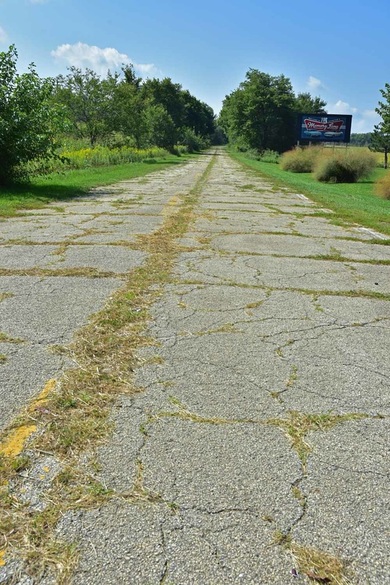 Section of old Route 66, preserved as "Memory Lane," in Lexington, Illinois Section of old Route 66, preserved as "Memory Lane," in Lexington, Illinois On Facebook recently, you mentioned that with visitors from Ireland, the UK, New Zealand, Spain, the Netherlands, Australia, Switzerland and Scotland, "the world came through the door today." What draws international visitors to Route 66? What are they most interested in and enthusiastic about? Our visitors from other nations are actually more drawn to the Route than Americans. I guess it could be the “Backyard Syndrome!” Route 66 is what true Americana is to the rest of the world. I believe through movies, the draw of the west, and music--our visitors have this wild adventurous road that they just have to experience for themselves. I think they are interested to see true Americana. They want to experience that "Andy Griffith Show” feel of America. 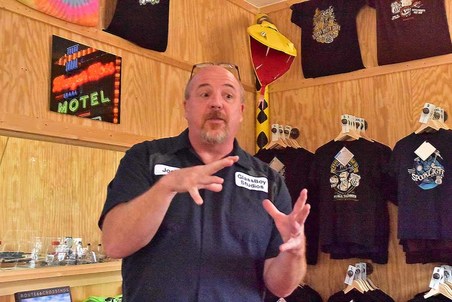 Joel, sharing a favorite Route 66 story Joel, sharing a favorite Route 66 story Do you see yourself as an ambassador for Route 66? I just love people. I guess if you see a host as an ambassador, then yes. I want people walking out of my shop with dreams and yearning for that spark that Saturday mornings used to bring to us as kids. I’m really more about the people than the business. I know that may sound weird, but money can’t buy how people on the Route make me feel, and I hope it is reciprocated. 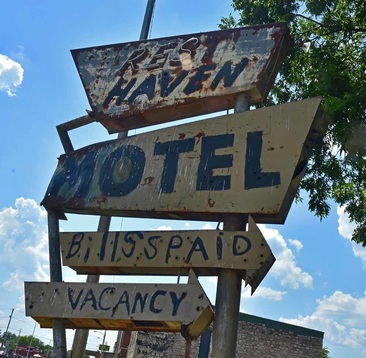 Old motel sign on Route 66 Old motel sign on Route 66 Tell me more about your work with neon – how you got started with that and how the work ties in with Route 66. It all really started the first couple of times I drove the Route out west. When I saw the Skyliner Motel sign in Stroud, Oklahoma, I knew I wanted to learn how to make signs the way they used to make them after WWII when the Route was jumping. It was quite a change from my previous work as a church youth director! 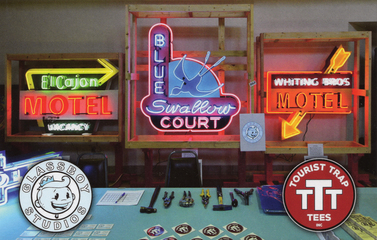 Promotional postcard for Glassboy Studios and Tourist Trap Tees Promotional postcard for Glassboy Studios and Tourist Trap Tees How long have you had the shop in Arcadia, and what's ahead for it? We celebrated our one-year anniversary at GlassBoy Studios on September 1st. Well, the first six months were spent remodeling! We will be constantly changing and morphing to make our stop a true must on the Route trip. I really just want to encourage people to have one heck of an adventure on America’s most famous road! |
Written from the heart,
from the heart of the woods Read the introduction to HeartWood here.
Available now!Author
Nan Sanders Pokerwinski, a former journalist, writes memoir and personal essays, makes collages and likes to play outside. She lives in West Michigan with her husband, Ray. Archives
April 2022
Categories
All
|











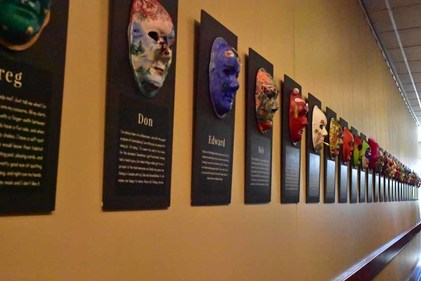
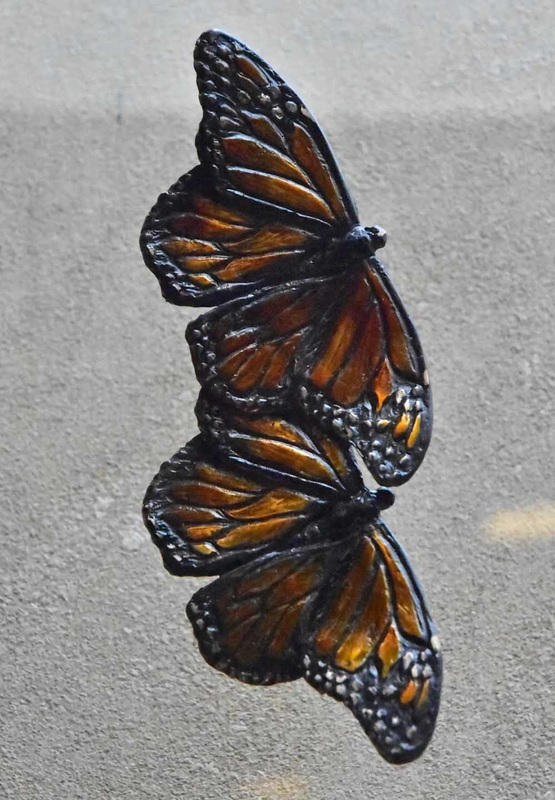
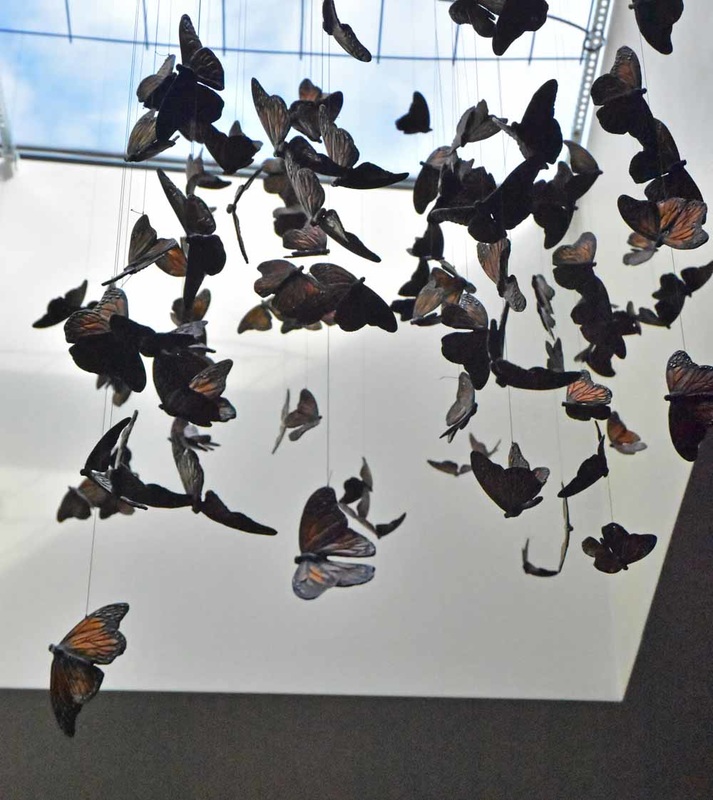
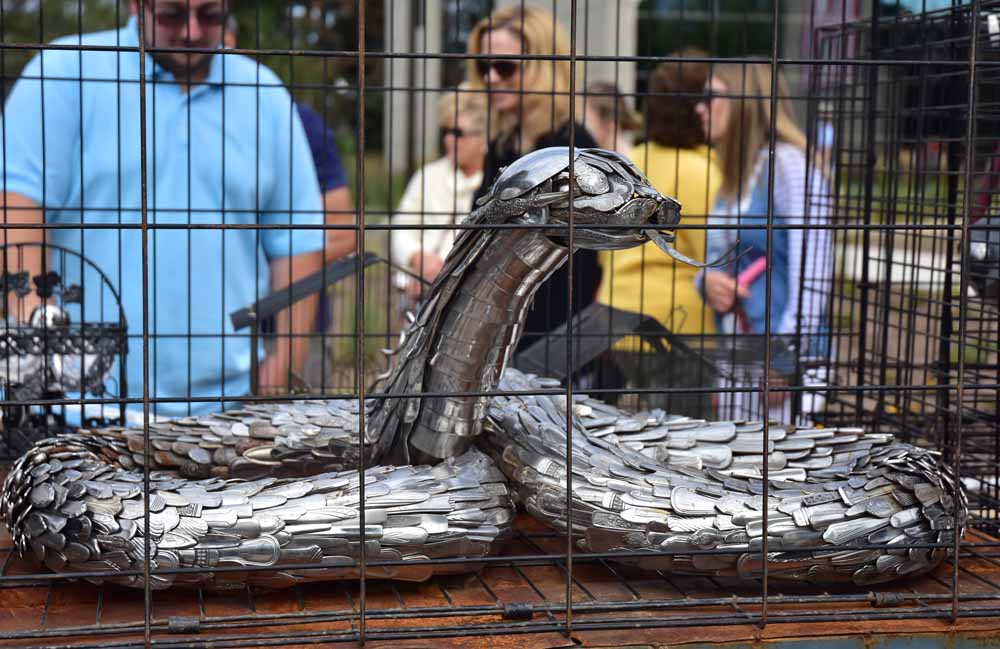
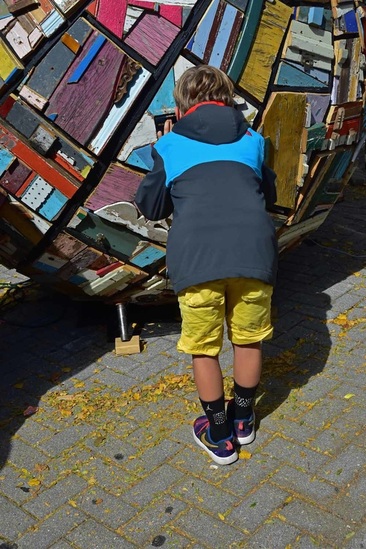
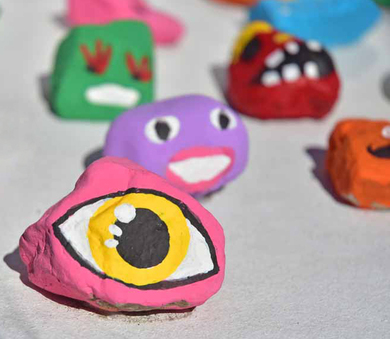
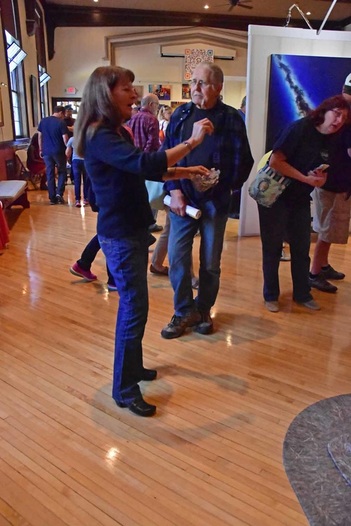
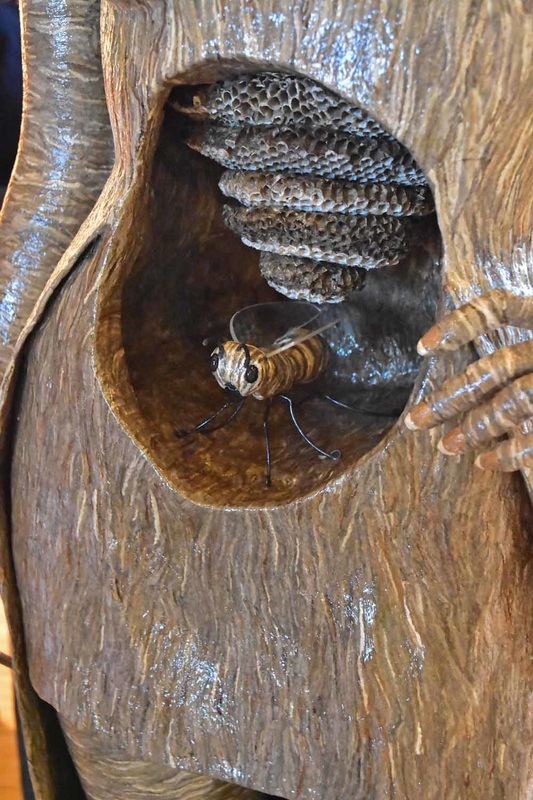
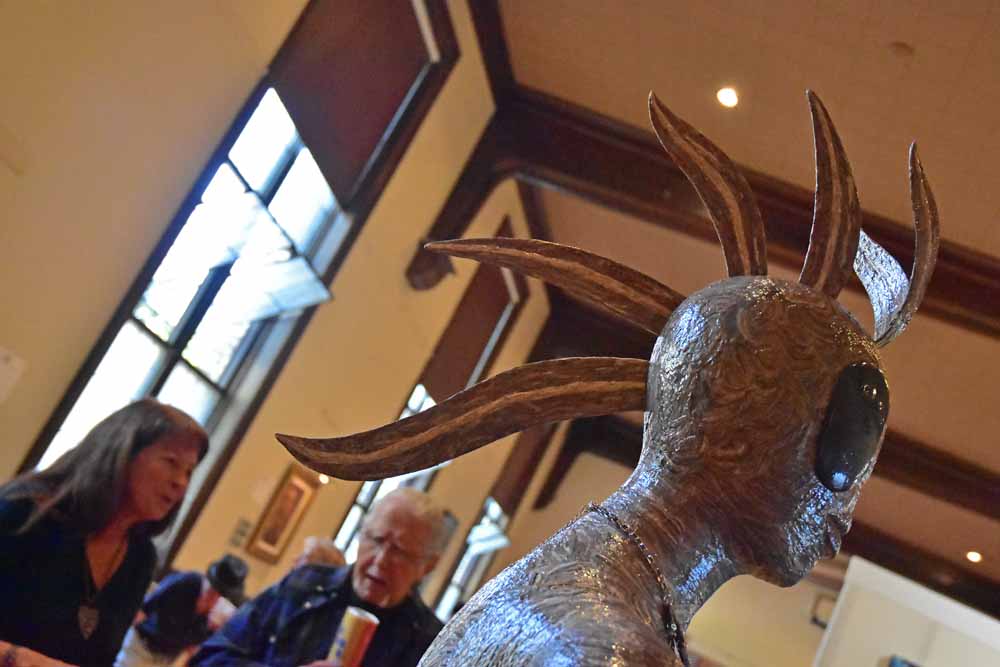
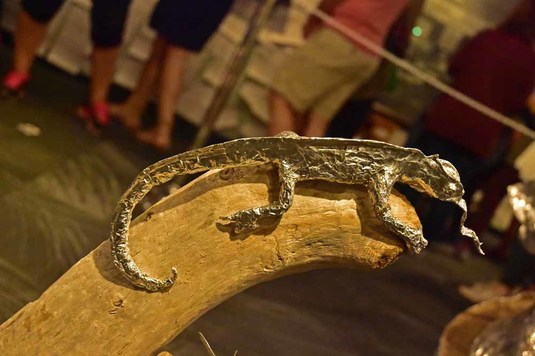
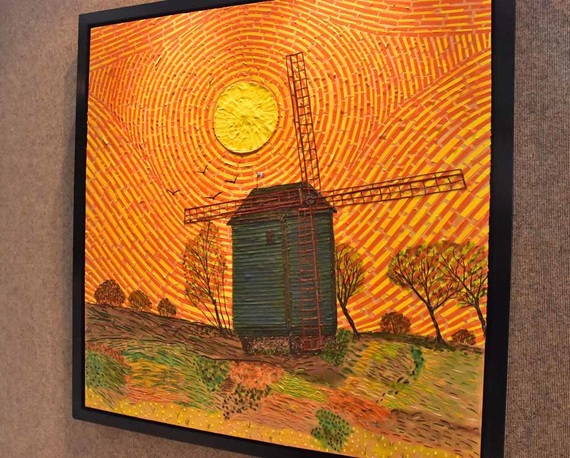
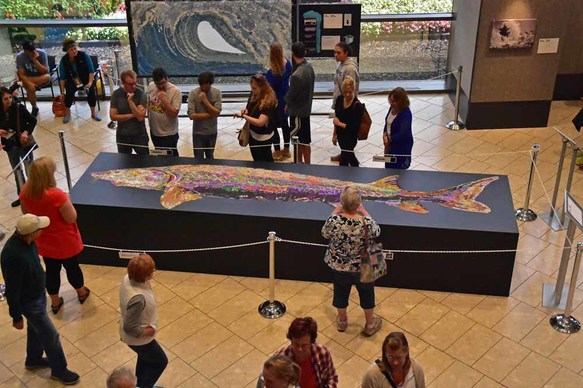
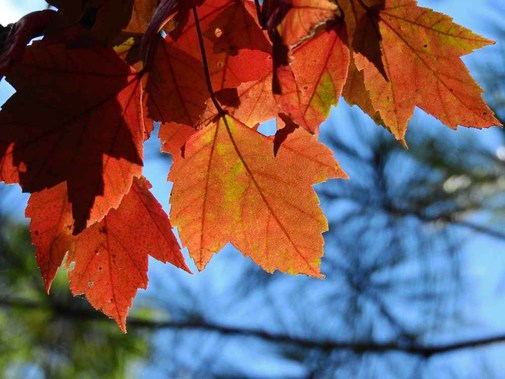
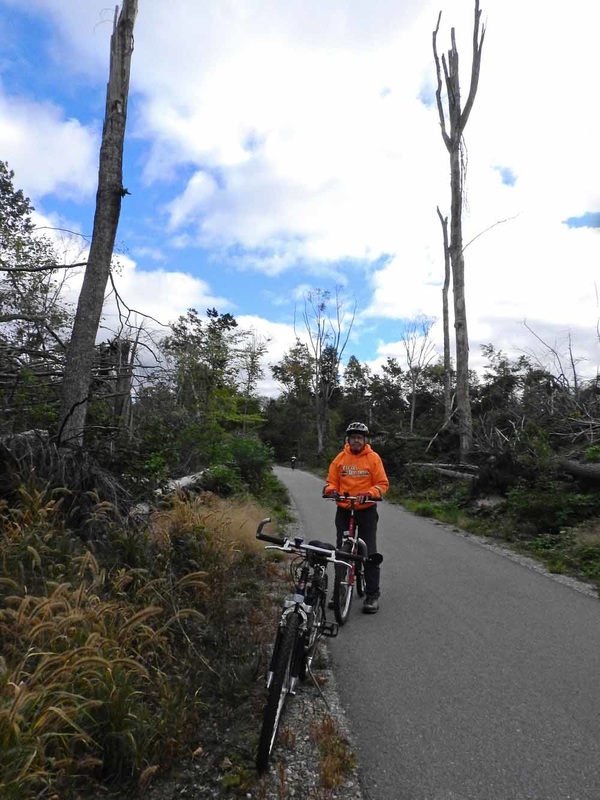
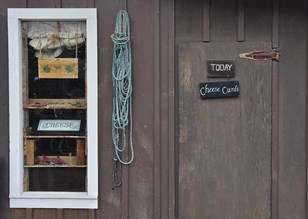
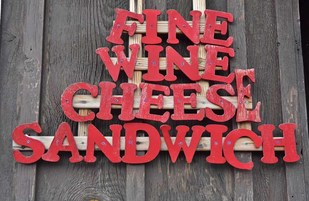
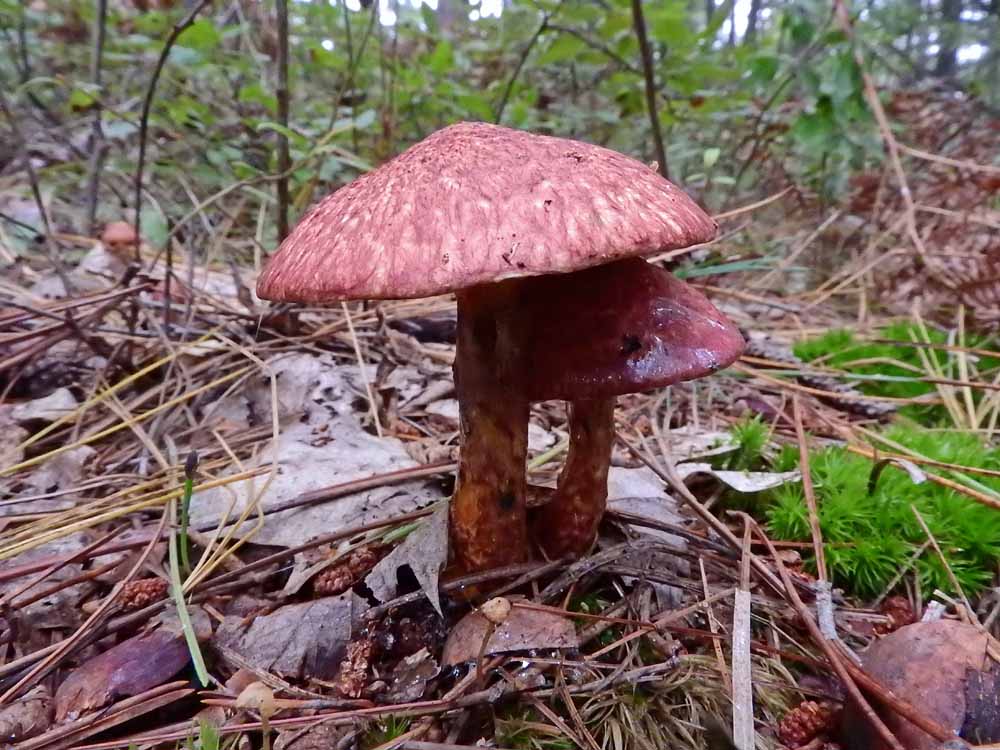
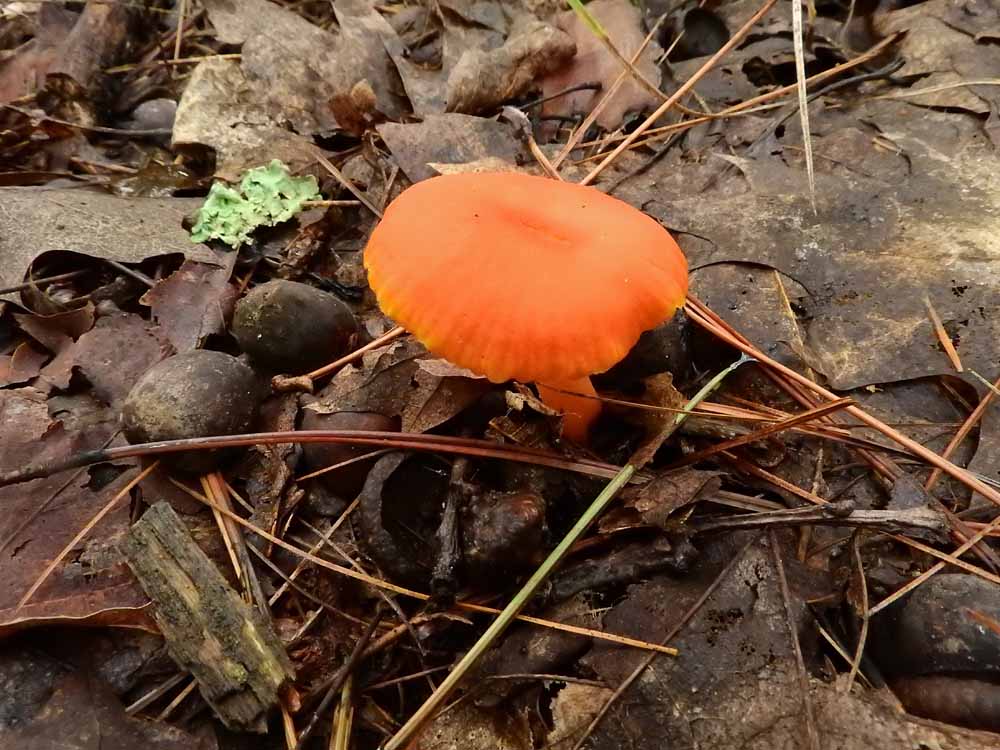
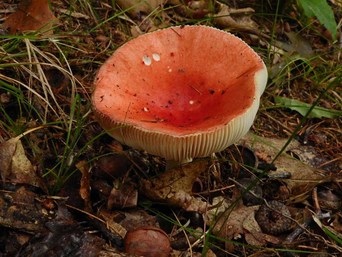
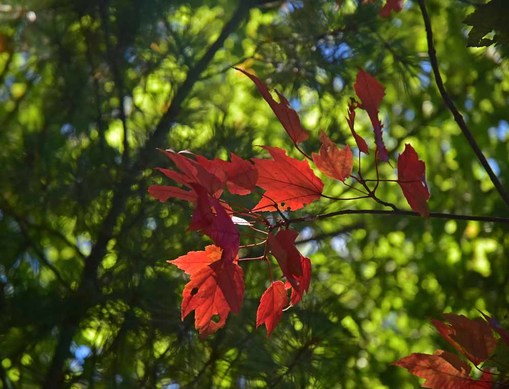
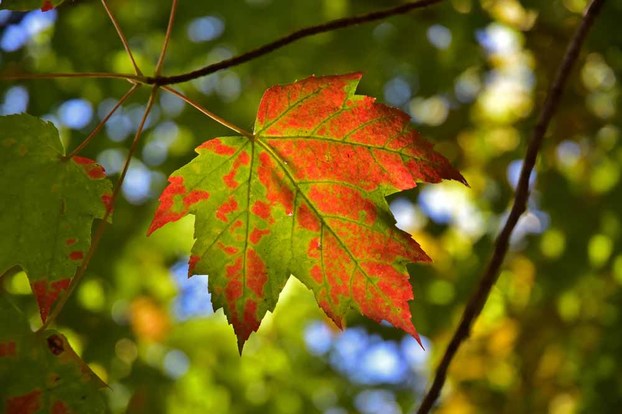
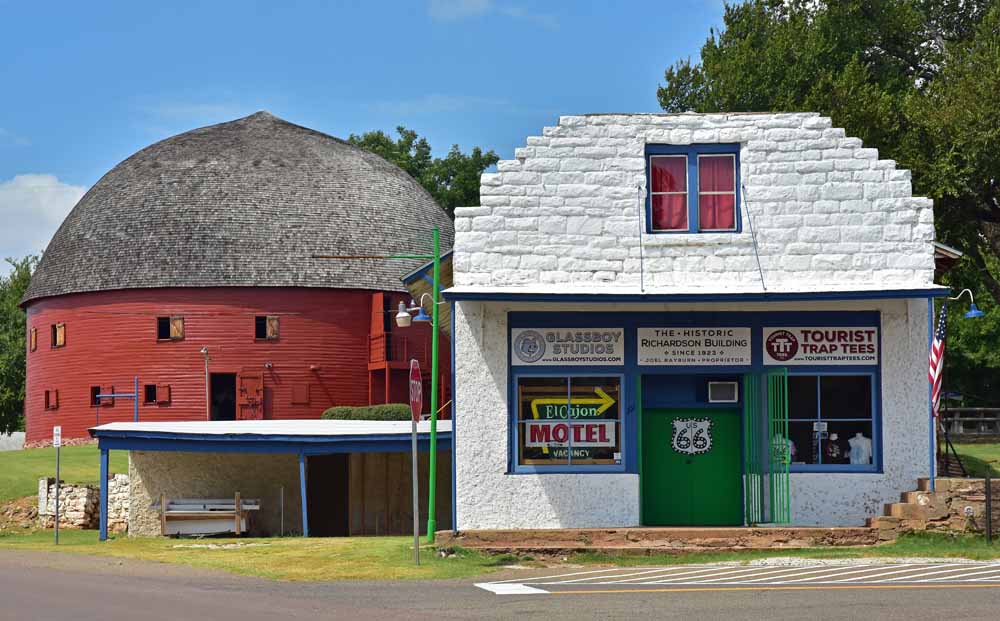
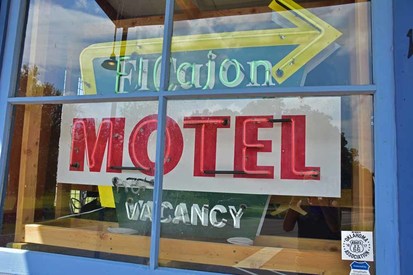

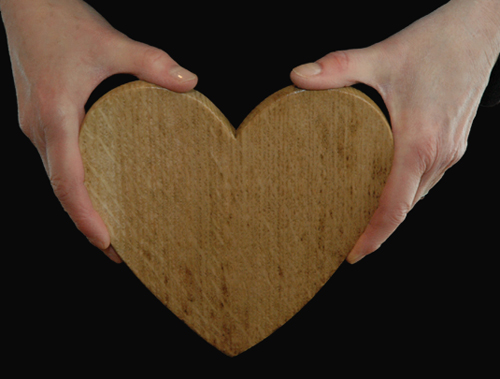
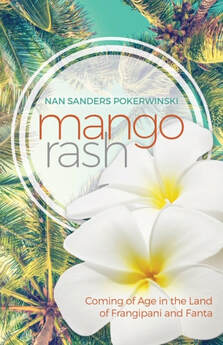
 RSS Feed
RSS Feed